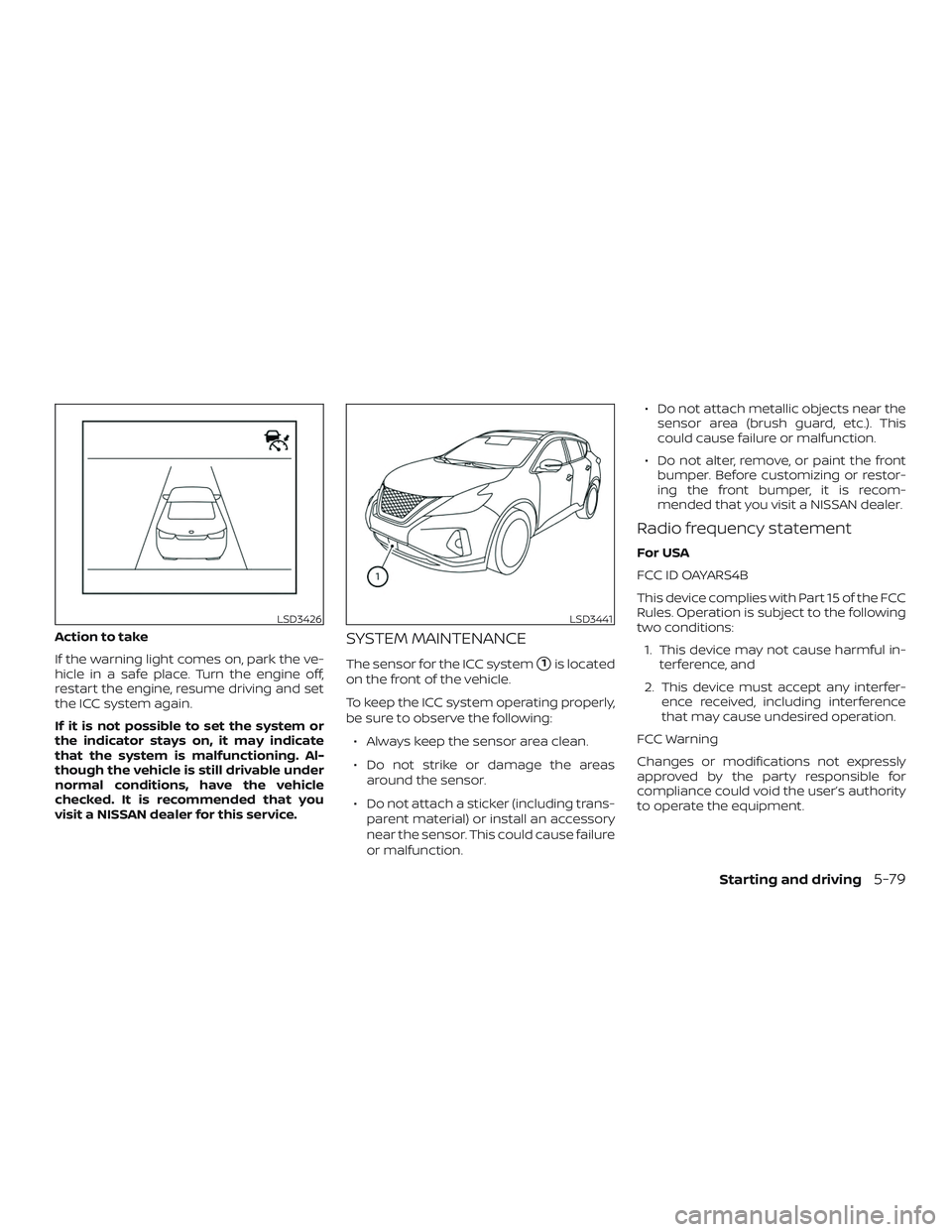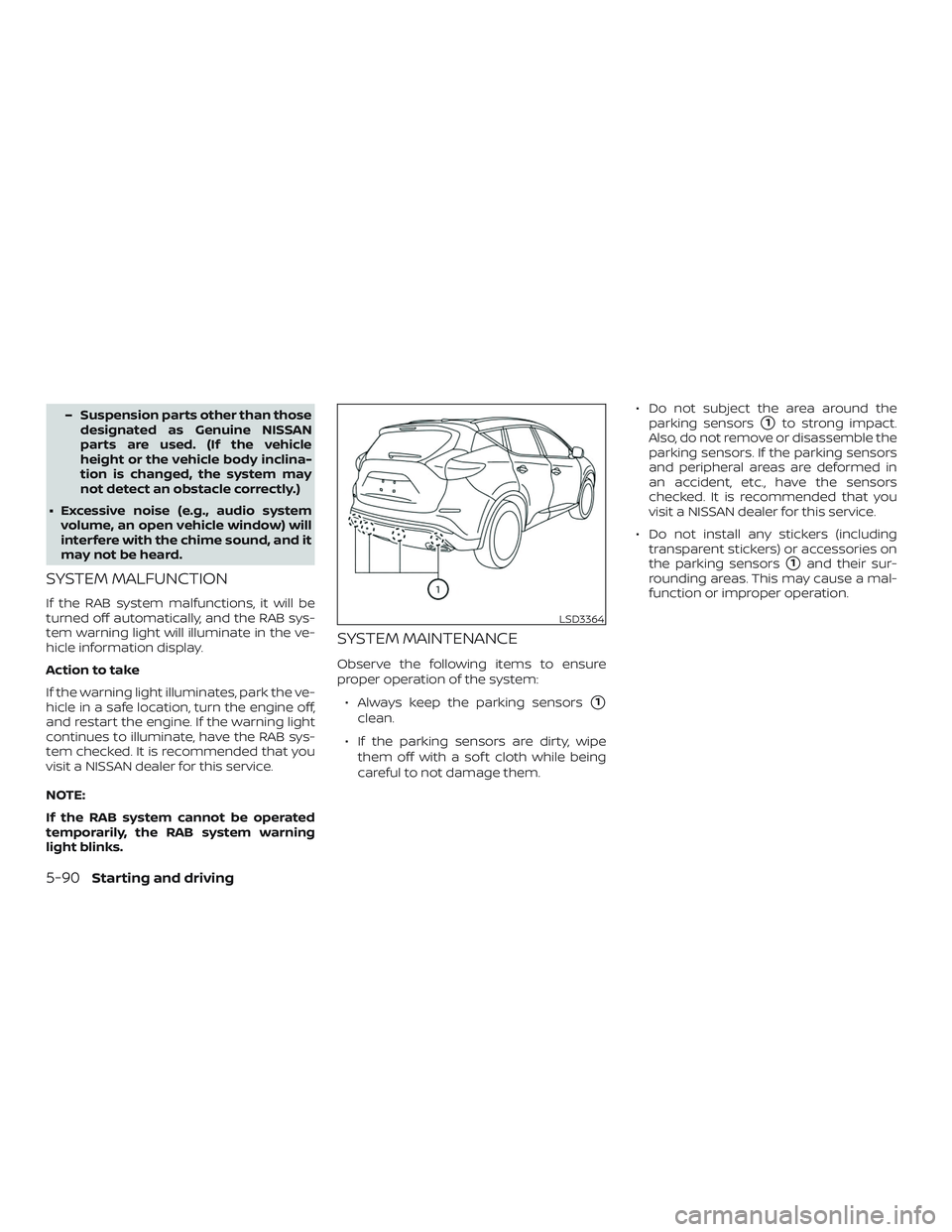Page 325 of 507

Action to take
If the warning light comes on, park the ve-
hicle in a safe place. Turn the engine off,
restart the engine, resume driving and set
the ICC system again.
If it is not possible to set the system or
the indicator stays on, it may indicate
that the system is malfunctioning. Al-
though the vehicle is still drivable under
normal conditions, have the vehicle
checked. It is recommended that you
visit a NISSAN dealer for this service.SYSTEM MAINTENANCE
The sensor for the ICC system�1is located
on the front of the vehicle.
To keep the ICC system operating properly,
be sure to observe the following:
∙ Always keep the sensor area clean.
∙ Do not strike or damage the areas around the sensor.
∙ Do not attach a sticker (including trans- parent material) or install an accessory
near the sensor. This could cause failure
or malfunction. ∙ Do not attach metallic objects near the
sensor area (brush guard, etc.). This
could cause failure or malfunction.
∙ Do not alter, remove, or paint the front bumper. Before customizing or restor-
ing the front bumper, it is recom-
mended that you visit a NISSAN dealer.
Radio frequency statement
For USA
FCC ID OAYARS4B
This device complies with Part 15 of the FCC
Rules. Operation is subject to the following
two conditions:
1. This device may not cause harmful in- terference, and
2. This device must accept any interfer- ence received, including interference
that may cause undesired operation.
FCC Warning
Changes or modifications not expressly
approved by the party responsible for
compliance could void the user’s authority
to operate the equipment.
LSD3426LSD3441
Starting and driving5-79
Page 329 of 507

To set cruising speed, accelerate your ve-
hicle to the desired speed, push the SET/–
�Cswitch and release it. (The color of the
cruise indicator changes to green and set
vehicle speed indicator comes on.) Take
your foot off the accelerator pedal. Your
vehicle will maintain the set speed.
∙ To pass another vehicle, depress the accelerator pedal. When you release the
pedal, the vehicle will return to the pre-
viously set speed.
∙ The vehicle may not maintain the set speed when going up or down steep
hills. If this happens, manually maintain
vehicle speed. To cancel the preset speed, use any of the
following methods:
1. Push the CANCEL switch. The vehicle speed indicator will turn off.
2. Tap the brake pedal. The vehicle speed indicator will turn off.
3. Turn the CRUISE ON/OFF switch off. Both the cruise indicator and vehicle
speed indicator will turn off.
To reset at a faster cruising speed, use one
of the following three methods: 1. Depress the accelerator pedal. When the vehicle attains the desired speed,
push and release the SET/– switch.
2. Push and hold the RES/+ switch. When the vehicle attains the desired speed,
release the switch.
3. Push, then quickly release the RES/+ switch. Each time you do this, the set
speed will increase by about 1 mph
(1.6 km/h). To reset at a slower cruising speed, use one
of the following three methods:
1. Lightly tap the brake pedal. When the vehicle attains the desired speed, push
the SET/– switch and release it.
2. Push and hold the SET/– switch. Re- lease the switch when the vehicle
slows down to the desired speed.
3. Push, then quickly release the SET/– switch. Each time you do this, the set
speed will decrease by about 1 mph
(1.6 km/h).
To resume the preset speed, push and re-
lease the RES/+ switch. The vehicle will re-
sume the last set cruising speed when the
vehicle speed is over 25 mph (40 km/h).
LSD3452
Starting and driving5-83
Page 332 of 507
�1RAB system warning light and RAB sys-
tem warning indicator
�2Steering-wheel-mounted controls (lef t
side)
�3Center display (if so equipped)
RAB SYSTEM OPERATION
When the shif t lever is in the R (Reverse)
position and the vehicle speed is less than
approximately 9 mph (15 km/h), the RAB
system operates.
If a risk of a collision with an obstacle is
detected when your vehicle is backing up,
the RAB system warning indicator will flash
in the vehicle information display, a red
frame will appear in the center display (for
vehicles with the Intelligent Around View
Monitor system), and the system will chime
three times. The system will then auto-
matically apply the brakes. Af ter the auto-
matic brake application, the driver must
depress the brake pedal to maintain brake
pressure.
LSD3365
5-86Starting and driving
Page 333 of 507
NOTE:∙ The brake lights of the vehicle come
on when braking is performed by the
RAB system.
∙ When the brakes operate, a noise may
be heard. This is not a malfunction.
LSD3434
Starting and driving5-87
Page 334 of 507

TURNING THE RAB SYSTEM
ON/OFF
Perform the following steps to turn the RAB
system on or off.1. Press the
button until “Settings”
displays in the vehicle information dis-
play and then press the OK button. Use
the
button to select “Driver Assis-
tance.” Then press the OK button.
2. Select “Emergency Brake” and press the OK button.
3. To set the RAB system to on or off, use the OK button to check the box for
“Rear.”
When the RAB system is turned off, the RAB
system warning light illuminates.
NOTE:
The RAB system will be automatically
turned on when the engine is restarted.
RAB SYSTEM LIMITATIONS
WARNING
Listed below are the system limitations
for the RAB system. Failure to follow the
warnings and instructions for proper
use of the RAB system could result in
serious injury or death.
∙ When the vehicle approaches an ob- stacle while the accelerator or brake
pedal is depressed, the function may
not operate or the start of operation
may be delayed. The RAB system may
not operate or may not perform suffi-
ciently due to vehicle conditions, driv-
ing conditions, the traffic environ-
ment, the weather, road surface
conditions, etc. Do not wait for the
system to operate. Operate the brake
pedal by yourself as soon as
necessary.
∙ If it is necessary to override RAB op- eration, strongly press the accelerator
pedal. ∙ Always check your surroundings and
turn to check what is behind you be-
fore and while backing up. The RAB
system detects stationary objects be-
hind the vehicle. The RAB system does
not detect the following objects:
– Moving objects
– Low objects
– Narrow objects
– Wedge-shaped objects
– Objects close to the bumper (less than approximately 1 f t [30 cm])
– Objects that suddenly appear
– Thin objects such as rope, wire, chain, etc.
∙ The RAB system may not operate for the following obstacles:
– Obstacles located high off the ground
– Obstacles in a position offset from your vehicle
– Obstacles, such as spongy materi- als or snow, that have sof t outer
surfaces and can easily absorb a
sound wave
5-88Starting and driving
Page 336 of 507

– Suspension parts other than thosedesignated as Genuine NISSAN
parts are used. (If the vehicle
height or the vehicle body inclina-
tion is changed, the system may
not detect an obstacle correctly.)
∙ Excessive noise (e.g., audio system volume, an open vehicle window) will
interfere with the chime sound, and it
may not be heard.
SYSTEM MALFUNCTION
If the RAB system malfunctions, it will be
turned off automatically, and the RAB sys-
tem warning light will illuminate in the ve-
hicle information display.
Action to take
If the warning light illuminates, park the ve-
hicle in a safe location, turn the engine off,
and restart the engine. If the warning light
continues to illuminate, have the RAB sys-
tem checked. It is recommended that you
visit a NISSAN dealer for this service.
NOTE:
If the RAB system cannot be operated
temporarily, the RAB system warning
light blinks.
SYSTEM MAINTENANCE
Observe the following items to ensure
proper operation of the system:
∙ Always keep the parking sensors
�1
clean.
∙ If the parking sensors are dirty, wipe them off with a sof t cloth while being
careful to not damage them. ∙ Do not subject the area around the
parking sensors
�1to strong impact.
Also, do not remove or disassemble the
parking sensors. If the parking sensors
and peripheral areas are deformed in
an accident, etc., have the sensors
checked. It is recommended that you
visit a NISSAN dealer for this service.
∙ Do not install any stickers (including transparent stickers) or accessories on
the parking sensors
�1and their sur-
rounding areas. This may cause a mal-
function or improper operation.
LSD3364
5-90Starting and driving
Page 338 of 507
1. Vehicle ahead detection indicator
2. AEB warning indicator
3. AEB system warning light
AEB SYSTEM OPERATION
The AEB system will function when your
vehicle is driven at speeds above approxi-
mately 3 mph (5 km/h).
If a risk of a forward collision is detected,
the AEB system will provide an initial warn-
ing to the driver by both a visual and au-
dible alert.
If the driver applies the brakes quickly and
forcefully af ter the warning, and the AEB
system detects that there is still the possi-
bility of a forward collision, the system will
automatically increase the braking force. If
the driver does not take action, the AEB
system issues the second visual warning
(red and white) and audible warning and
also applies partial braking.
If the risk of a collision becomes imminent,
the AEB system applies harder braking au-
tomatically.
LSD3436
5-92Starting and driving
Page 339 of 507
NOTE:
The vehicle’s brake lights come on when
braking is performed by the AEB system.
Depending on vehicle speed and distance
to the vehicle ahead, as well as driving and
roadway conditions, the system may help
the driver avoid a forward collision or may
help mitigate the consequences of a colli-
sion, should one be unavoidable. If the
driver is handling the steering wheel, accel-
erating or braking, the AEB system will
function later or will not function.
The automatic braking will cease under the
following conditions:∙ When the steering wheel is turned as far as necessary to avoid a collision.
∙ When the accelerator pedal is de- pressed.
∙ When there is no longer a vehicle de- tected ahead.
If the AEB system has stopped the vehicle,
the vehicle will remain at a standstill for
approximately 2 seconds before the
brakes are released.
LSD3437
Starting and driving5-93